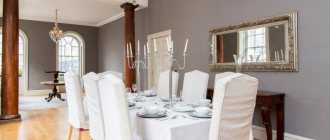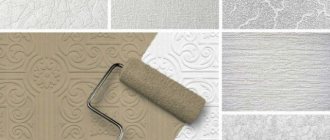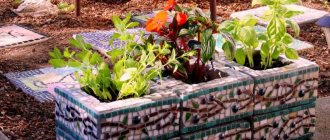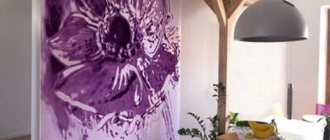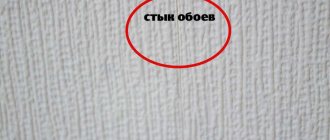Do you want to easily update the design of your room, but don’t know how to do it? One of the most optimal and budget options is to paint the wallpaper with special paint. Using this method you can easily make a room bright, stylish and unusual. However, any paint will not work for this. All compositions differ from each other in performance characteristics. Below is a rating of the best wallpaper paint in 2021.
Wallpaper for painting
Modern paintable wallpaper provides an excellent opportunity to change the color of the walls at any time. At the same time, the costs of this procedure will be minimal, and the effect of transforming the room will be maximum. This is very important to consider when choosing wallpaper for the kitchen. What wallpaper is suitable for the kitchen should be a deliberate decision. As for the advantages of such wallpaper for painting, this largely depends on its type.
Advantages
The general advantages are:
- Such wallpapers have a long service life; they can be repainted 8 or more times.
- You can purchase wallpaper with a white base, as well as in color; They can also be painted in any shade.
- Wallpaper for painting is presented in different types, in a large assortment, that is, the choice is quite wide.
- They are convenient and quick to glue; The width of the rolls can be up to 106 cm.
- The joints of the wallpaper edges are practically invisible.
- They are much stronger than ordinary wallpaper; they are difficult to scratch by furniture or anything else.
- It is not difficult to remove such wallpaper from the wall: just peel off one edge, pull it, and then the wallpaper can be easily removed (with the exception of glass wallpaper).
- Painted wallpaper does not fade when exposed to direct sunlight.
Types for walls and ceilings
The entire group of wallpaper intended for painting is distinguished by deep relief and the absence of a color pattern. That is why they are called textured. They differ from each other in the material on which they are made. Today there are four types of wallpaper for painting.
Paper
Usually this is a two-layer embossed paper wallpaper, the first layer of which is treated with a special moisture-resistant compound. Some manufacturers add a third layer between the base and the coating, into which sawdust and shavings are placed. In this case, a relief is created on the surface.
Paper wallpaper is impregnated with a water-repellent composition; they are quite thick and dense. They are easy to glue on a flat surface.
You can decorate both walls and ceilings with paper wallpaper. In some cases, seamless ceiling tiles are used. This creates the visual effect of a seamless surface.
Non-woven
This type is considered the most successful among all paintable wallpapers. Such wallpaper consists of a non-woven base and vinyl coating that simulates the relief. Unlike paper wallpaper, such wallpaper must be painted, since both layers are quite fragile. However, after painting they become quite strong and durable. You can change their color up to 15 times.
When gluing non-woven wallpaper, the glue is applied exclusively to the surface of the wall. This greatly simplifies the work process. In addition, they do not shrink, swell or deform.
A big advantage of non-woven wallpaper is its ability to hide wall imperfections: small unevenness, cracks, even those that formed after the sticker. In addition, they “breathe”, that is, they allow air to pass through and do not contain substances hazardous to the body. How is vinyl wallpaper on non-woven backing carried out? There are certain subtleties in gluing technology that should not be neglected.
Vinyl
The basis for vinyl covering can be not only non-woven fabric, but also paper. Vinyl wallpaper comes in white and pastel colors. The latter option is more attractive, since after applying the paint the color becomes rich and bright. The texture of the wallpaper is usually embossed (herringbone, wave, matting, pimples).
You can say exactly which wallpaper is better, vinyl or non-woven, only by carefully studying their properties and characteristics.
Glass wallpaper
They received this name due to the fiberglass threads that are connected to the paper base. As a result, the wallpaper receives a very interesting relief structure with an unusual pattern or ornament.
Decorativeness and the ability to correct small flaws in the walls are the main advantages of this type of wallpaper. In addition, glass wallpaper is wear-resistant, durable and fireproof. After painting, they can even be washed with a brush. The only negative: glass wallpaper is difficult to remove from the walls.
Linkrust
This latest trend is a material created exclusively from natural substances. The basis of this wallpaper is paper or textiles. A mixture of wood flour, wax, linseed oil, chalk and rosin is applied to them.
They must be wetted before gluing.
All types of wallpaper for painting are quite functional. They can decorate walls not only in residential premises, apartments, but also in offices, hotels and other public institutions. What paint to choose for wallpaper?
General recommendations for painting
In addition to the specific features for each type of wallpaper and paint, there are several general recommendations for painting. They will be related to the practicality of the process, as well as its safety for humans.
The work of painting wallpaper should begin with the preparation of the room where it will take place. All furniture that interferes with the process should be removed or moved from the room. This will also help prevent it from getting dirty.
Before painting, most wallpaper should be cleaned and degreased. Otherwise the paint may come out crooked. In the end, everything will have to be redone. Worst case scenario is to re-glue the wallpaper.
Wallpaper must be cleaned before painting.
It is important to prepare the room for painting. It is recommended to cover the floor and seal the baseboards. Otherwise, there is a risk of staining everything with paint. And if it dries, you will most likely have to remove it with a solvent, and this is a rather difficult task.
Before painting the wallpaper, cover the floor with film
It is not recommended to stay in a room with painted wallpaper for a long time. Almost any undried paint has a specific, pronounced odor. Inhaling it may cause dizziness.
In addition to painting, wallpaper can be further decorated or protected. The simplest solution would be to coat the product with colorless varnish. This will increase the life of the paint and also additionally protect the surface of the wallpaper from external influences.
Varnish will provide additional protection for painted wallpaper
Another option would be to apply different patterns. Or use matte varnish, which will add additional shine to the wallpaper surface. At the decoration stage, it is possible to show any creative impulses. And in case of failure, they can be painted over.
Choosing paint for wallpaper to paint is a primary task. The service life and appearance of the product will depend on his literacy. Wallpaper should fit into the overall interior of the room and the entire house. And also a very important step is painting them. It should be approached with special care. However, as a result of the work, the house will sparkle with new colors.
Types of wallpaper paints
The type of wallpaper paint is selected according to the type of wallpaper. The appearance of the walls and the wear resistance of the paint largely depend on this. Today there are three types of water-soluble paints intended for painting wallpaper:
- Acrylic:
- Latex;
- Polyvinyl acetate (PVA);
Acrylic
Acrylic paint is in greatest demand. It is durable, quite moisture resistant; The range of colors on the market is huge. In addition, acrylic paint dries almost instantly.
Water-soluble and water-emulsion
Water-soluble or water-based PVA-based paint is the cheapest of all types. But its characteristics are inferior to other types of paints. It is afraid of moisture, so it is suitable for painting ceilings exclusively in dry rooms.
Latex
Latex paint adheres perfectly to wallpaper, creating a silky matte surface. High moisture resistance is the main advantage of latex paint.
When purchasing latex paint, pay attention to the gloss level indicated on the label. The higher it is, the more moisture-resistant the paint is.
Paper wallpaper can be painted with any colorful material presented above. However, latex paint works best on paper.
Non-woven and vinyl wallpapers are more prone to acrylic, but latex paint is also quite suitable for them. But if we are talking about painting the inside of the wallpaper (this is possible for some types of non-woven wallpaper), then only acrylic paint is used.
To paint fiberglass wallpaper, use any of the above water-based paints.
Wall painting design
There are a lot of options for painting walls, because there are no restrictions on quantity
It is important to find the right suitable color combination when painting your walls. The easiest way to do this is to select shades according to the tables that designers use
They contain groups of shades that can be used in one room, while the interior will be harmonious.
Now about the methods of combined painting of walls. There are quite a lot of them, they will look different in the interior. Choose the one you like.
Horizontal division into two or three zones
This method is traditional. Usually the room is divided into two zones. At the bottom they paint with darker shades, at the top with lighter shades. The classic version is divided into three parts by height - the lower third is painted with a dark shade, the upper two are lighter. But this is just a classic; in reality, the dark paint can end in the middle or almost at the ceiling. You just need to be careful with this technique: it visually makes the ceilings lower. The exception is a light strip almost under the ceiling.
Painting a room in two colors: horizontal division
The border between two colors, if you paint the walls in an apartment yourself, is rarely ideal. To decorate the imperfections, you can glue a molding or some even stripes. Another option is to apply masking tape evenly along the border before applying the second shade. After painting, remove it, you will get a perfect line (if you applied the tape evenly).
The molding can be left white - it goes with any colors, or it can be painted in one of the suitable colors
This technique can be used in premises of any purpose, and the style can be of any kind. Only with moldings - this is more of a classic, it is acceptable for country style, for one of the ethnic styles. Just a clear border or a division decorated with a shiny stripe is already minimalism or hi-tech.
Accentuating a wall
A fashionable trend in decorating rooms is highlighting a wall with color. There are two options here:
- a darker shade of the same color;
- another color from a compatible palette.
With well-chosen details in the interior, both methods look attractive. This is the easiest way to make the interior more memorable and vibrant.
A bright color from the same palette is the easiest way to brighten up your interior.
Just keep in mind that in bedrooms, for example, it is better to use less harsh combinations - the atmosphere in such rooms should be softer. Sharp contrasts are good in living rooms and children's rooms. Children generally like bright combinations.
The colors in the bedrooms are calmer
Horizontal stripe
This is a fairly wide strip that runs approximately at eye level
Most often, this type of painting of a room is used if it is necessary to pay attention to some decorative elements - paintings, for example.
A wide horizontal stripe is another way to paint a room in two colors.
This technique looks good in corridors - by lowering the height of the ceiling, it makes it seem wider. Another popular application is children's rooms: children's drawings look very good against a prominent background.
The stripe does not have to be monochromatic - a slight gradient is also good
Striped walls
An interesting technique, but it’s not worth using it for the entire room. This way you can decorate one wall - one of the varieties of an accent wall - or just part of it.
Horizontal stripes can be multi-colored. The main thing is that they are repeated in the interior
An interesting effect is achieved by combining stripes of the same color, but with different textures - matte and glossy. Strictly speaking, these are not two colors, but they look exactly like that.
Combination of matte and glossy paint stripes
Highlighting some interior details
Often, some details are emphasized with a different color - brighter or calmer. For example, niches, frames, placement of an interesting shelf, etc.
Highlighting some elements is another way to combine painting a room.
One option is to outline the walls with a stripe of a darker color, thus highlighting all the corners. This method will help make a small room more spacious: it will appear taller and wider.
A way to visually enlarge a room
What does the modern market offer?
The modern market is replete with a wide range of textures and colors that are used in wallpaper for painting. Everyone will be able to choose exactly the option that ideally matches the style and design of the room being decorated and paint them in the desired color. In addition, various wax pastes can be used to decorate individual parts and relief elements. Can be coated with glaze, varnish or shaded. All this will help make your living space unique. To make changes, you can use decorative plaster with your own hands from ordinary putty.
The choice of manufacturers of wallpaper, paints, and adhesives is also very wide. Foreign wallpaper manufacturers:
- "ERFURT", "MOHR", "MARBURG", "ERISMANN", "AS CREATION", "ERISMANN", (Germany).
- "MITEX", "TASSO GLASS" (Sweden).
- "FINTEX", "ASSATEX" (Finland).
- "MERMET" (France).
- "ARTE" (Belgium).
Among the paints, the most popular brands are: Dufa, Tikkurilla, Garmonia, Beckers-3, EURO12.
The sizes of rolls of textured wallpaper for painting sometimes differ from the standard ones (10.05 x 0.53 m) in the direction of increase. You can find wallpaper with dimensions 17 x 0.53; 25 x 1.06; 33.5 x 0.53 and even 125 x 0.75 m. The maximum length allows you to use material more efficiently and almost get rid of scraps. Double width helps reduce the number of joints.
How to correctly calculate the amount of paint
For painting, you must correctly calculate the amount of paint needed. These calculations are carried out according to:
- surface area for processing;
- absorption of substances by each material;
- paint consumption per square meter.
All paints indicate the consumption of the substance per 1 square meter. Based on this, you can calculate how much money you will need.
It should be taken into account that paper and non-woven wallpaper absorb moisture better and more paint will be required to paint them.
How to glue it yourself
There is nothing complicated about painting and gluing yourself. In order to glue and paint, you will need the following tools and materials:
- paint and coloring element;
- fur roller and brushes;
- plastic bath;
- gloves;
- container for diluting paint;
- masking tape;
- acrylic varnish (if necessary).
How to paint:
- Preparing the walls. The wallpaper on the walls should dry well. There is no need to rush into painting; it is better to wait for the time specified in the instructions. Usually this is 2-4 days after wallpapering. If bubbles have formed in certain areas, they must be cut and re-sealed with PVA glue. Painting should begin after the areas have completely dried.
- Dilution of paint. Here it is important to follow the proportions indicated in the instructions. Important! The diluted composition should not be too liquid.
- Applying paint. To do this, use a roller made of porous material, for example, foam rubber. During operation, smudges may form. They need to be carefully collected with the end of the roller, then paint over the area again. The same goes for the bubbles that sometimes form when painting.
Work should not be carried out with open windows. This promotes the formation of air bubbles.
Things to consider
- The paint dries from 2 to 14 hours. After this, you can apply a second layer of paint: the color shade will be more beautiful and rich.
- Use a paint brush where it touches the floor. Pre-cover the baseboard with masking tape.
- If desired, the painted surface can be coated with acrylic varnish. This coating will provide protection from dirt, so this is an ideal solution for the kitchen, hallway and children's room.
- If you can’t find the right shade of paint, tint the white base with any of the tint dyes.
Selection rules
How to choose wallpaper paint for painting depends on the quality of the base on the walls, the percentage of humidity in the room and, of course, the budget for repairs. Let's consider all types of coloring compositions that are used to give a new shade to wallpaper.
Acrylic paint
Acrylic paint for wallpaper for painting is a water-based material. The richest palette of wallpaper paints belongs to acrylic compositions. The binder in them is acrylic resin.
It is different:
- moisture resistance;
- allows air to pass through, which is why it is called “breathable”;
- has a huge number of shades - you can choose for every taste;
- not exposed to sunlight;
- remains on the wall for a long time and does not change its color for years.
High-quality, expensive compositions are very economical, because one layer is enough to paint over the previous shade.
Acrylic paint for wallpaper dries quickly and is odorless. It does not release harmful chemicals into the environment, therefore it is successfully used in the interior of children's rooms.
There are nuances when using different types of foundation:
- Suitable for paper webs.
- For vinyl wallpaper, acrylic paint must have a latex base - this is mandatory.
- Acrylic trellises can be safely painted with acrylic compounds.
- Acrylic is a good paint for non-woven wallpaper.
Water-based paint
Silicate compositions are made on the basis of silicate glue and pigments. They last a long time and are resistant to weather conditions.
Mineral ones contain cement and lime. They have a disadvantage - a short service life.
When painting wallpaper with water-based paint, a pigment is added to it - color
It is important to immediately calculate the quantity correctly, or better yet, with a reserve, because if the composition is not enough, it will be difficult to achieve a complete color match
Latex paint
Creates a thin film of polymer material due to fine particles, which stick together when water evaporates and create a durable coating that:
- long-term use;
- easy to clean from dust and dirt;
- does not suffer from humidity.
When painting the base with latex compounds, it is not recommended to cover the wall with a classic primer, as this prevents the paint from being absorbed. It will be difficult to distribute evenly over the surface. The first layer is applied diluted, the second - normal.
If you take breaks in work, the joints will be noticeable, so the entire wall needs to be painted at once. The roller should not be made of foam rubber, as it creates air bubbles that burst when dry. If drips occur, they should be removed immediately before they dry.
Polyvinyl acetate paints have one significant advantage - they are cheap, since they are an aqueous solution of PVA glue with the addition of pigment. The downside is that such materials do not adhere firmly to the base and can get dirty if touched. Also, PVA paints deteriorate from the cold. It is advisable to use them in warm living spaces in places that are out of reach - behind furniture, in a closet.
Alkyd paints are sensitive to moisture, but are well suited for dry rooms. Inexpensive. Can be cleaned with detergents. But there is one significant drawback - the alkyd film does not breathe, so condensation may appear when temperature changes occur. Well suited for fiberglass and fiberglass wallpaper.
Tikkurila paint
The well-known Tikkurila brand is represented by various paint and varnish materials, including those for painting wallpaper. Has positive characteristics:
- easy to clean with conventional means;
- has increased abrasion resistance and is not afraid of numerous cleanings;
- completely safe for health, which is confirmed by environmental certificates;
- has no smell;
- economical - one full layer of coating is enough, and the previous color will not show through the new one;
- easy to apply.
It is allowed to paint wallpaper in medical institutions.
It is better to choose painting materials based on the type of base:
- For paper wallpaper it is better to use latex. Thin film does not create additional stress on thin paper. Can be repainted several times.
- It is better to paint the non-woven base with acrylic or latex.
- The vinyl base is more similar to acrylic. But if vinyl trellises have a non-woven base, then latex is also used.
- The fiberglass base accepts all types of paints, just like paper ones. But fiberglass can be painted up to 10 times.
You need to start covering the wallpaper no earlier than 2-3 days after gluing, so that the wallpaper glue is completely dry.
Conclusion
Paintable wallpaper is an excellent solution for frequently changing the decor of a room. Their use will significantly save time and physical effort during subsequent repairs. It will be enough just to repaint the walls or ceiling if there is wallpaper that can be painted. And it’s not at all difficult to do this; you can do it on your own without involving professionals. And the wide selection of materials offered on today’s market will allow you to create a unique interior in any room.
We also recommend that you familiarize yourself with the types of granite.
What wallpaper can be painted
Wallpaper intended for repeated palette changes is marked “for painting”. However, the absence of this mark does not mean that the canvas cannot be repainted at all.
Glass wallpaper
Fiberglass wallpaper is made on the basis of glass fibers, which form a single piece. This finish is characterized by high moisture resistance, wear resistance and long service life.
Glass wallpaper is vapor- and air-permeable, so it is suitable for covering wet rooms - bathrooms, bathrooms and kitchens. This finish lends itself well to repainting. The highest quality specimens can withstand up to 20-25 times.
Non-woven
Non-woven wallpaper is made from non-woven (cellulose) fibers. The threads can be modified and reinforced with polyester fibers. The finished material is elastic, moisture-resistant and pleasant to the touch. Increasing the density of the canvas makes gluing more difficult and requires leveling the surface, but increases resistance to water, wear and paint.
The following types of non-woven wallpaper are available on the building materials market:
- non-woven interlining (both the base and the coating are made of cellulose fibers);
- non-woven paper (the bottom layer is made of non-woven material, and the surface layer is made of paper);
- non-woven vinyl (the covering is made of flat or foam vinyl).
Non-woven products are well suited for repainting. The choice of dye is determined by the properties of the surface layer.
Finishing of the canvas
After the top layer of paint has dried, you can transform the canvas yourself. To do this, you can independently apply other shades to the surface of the wall or draw any patterns and designs that your imagination can allow.
In order to strengthen the wallpaper, it is necessary to apply a layer of transparent varnish to it - this method will provide them with additional protection and resistance to moisture.
Selecting a texture
To highlight the texture against the background, use a brighter tone of paint, and apply it with a brush or roller with a small pile. This way the paint will only lie on the surface and will not cover the raised depressions.
Combining colors
Don't be afraid to combine colors. If you have no idea what tones to use, you can look at the work of designers and get ideas from there.
Do-it-yourself drawing
You can apply a design on the canvas with your own hands. To do this, it is possible to use improvised means.
Using a roller
Using a roller with different coatings, you can easily paint a large area of the wall. Depending on the material on the instrument, the pattern may visually change.
Using a stencil
If you purchase or make a stencil yourself, you can depict various figures, inscriptions, patterns and other designs on the canvas. To do this, you need to glue the stencil to the surface of the wallpaper and paint over the entire area. After this, you can remove it and let the paint dry.
By hand
Any brushes are suitable for freehand painting. The size should be chosen depending on the scale of the intended work.
Application of stamps
To apply an interesting design, you can make stamps at home. For these purposes, any available items with a border of an unusual shape are suitable, which should be dipped in the desired color and simply leaned against the canvas.
Features of coloring non-woven wallpaper
There are several technologies for coloring non-woven wallpaper. If the structure of the selected wallpaper is fairly uniform or there is a relief pattern on it, but you want the resulting shade to be uniform, then the wallpaper must be painted from the outside.
How to paint non-woven wallpaper to get a more embossed pattern? To do this, you need to apply the coating from the reverse side, using a more saturated color. Due to its hygroscopicity, non-woven fabric will absorb the pigment, and the shade will become visible from the front side, and the convex pattern will remain white. Painting must be done immediately before gluing the wallpaper to the wall.
Video on how to paint non-woven wallpaper:
Is it necessary to paint non-woven wallpaper from the reverse side if you want to emphasize the design? No. You can also paint from the front side, but in this case it will be necessary to remove the coloring composition from the polymer layer with a damp sponge. This will result in a more contrasting pattern.

